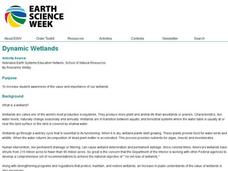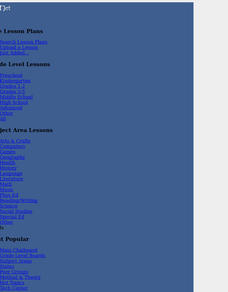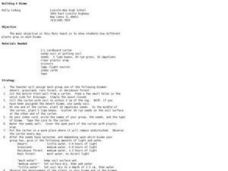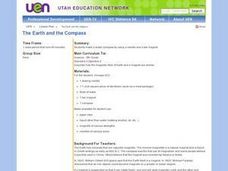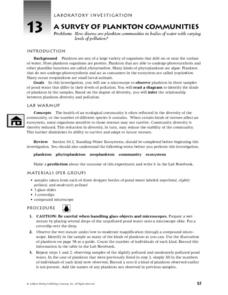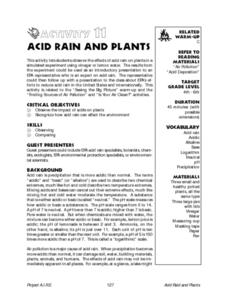Curated OER
Understanding pH, Alkalinity, and Hardness
Students comprehend the interactions of pH, alkalinity, hardness, and carbon dioxide in aquaculture water. They read the SRAC fact sheet number 464 "Interactions of pH, Carbon Dioxide, Alkalintiy and Hardness in Fish Ponds." Students...
Curated OER
Ecology 5 - Carbon and Oxygen Cycles
High schoolers construct their own diagrams outlining the pathway of carbon and oxygen in our atmosphere. They listen to a lecture on the carbon cycle while drawing an example of the carbon cycle on the board. Students comprehend that...
TryEngineering
Irrigation Ideas
Students design and build an irrigation system that can move water from one place to another. In this engineering lesson, students test whether their system can move two cups of water to at least three feet from the source. They evaluate...
Curated OER
DNA Extraction Lab
Students extract DNA and test for its presence from unroasted (raw) wheat germ using a prescribed procedure. They modify the procedure to provide a less expensive, easier method. They also extract DNA from different available plant,...
Curated OER
Do As the Romans: Construct an Aqueduct!
Students explore how the Romans engineered and built aqueducts. They read a manual, explore the Construct a Roman Aqueduct online activity, and construct an aqueduct that will transport two liters of water across a short distance in the...
Curated OER
Dynamic Wetlands
Students construct and observe a model of two different types of wetlands. In this wetlands lesson, students create a model of a wetland with constant drainage and a wetland that maintains a well-saturated soil. Students observe and...
Curated OER
Dispersement of Particles: Diffusion and Osmosis
Students explore the dispersement of particles. In this science lesson plan, students describe the many ways in which particles move and transfer from one source to other areas.
Curated OER
Pollution
First graders identify and discuss different kinds and sources of of pollution. They explain why it is important to keep the environment free of pollution. They make a poster depicting the dangers of pollution and make litter boxes.
Curated OER
Evaporation
Fourth graders study the water cycle and the different processes involved, specifically evaporation. They explore the processes of evaporation through hands-on collaborative activities and relate learning to life through...
Curated OER
Wetland/Estuary Structure and Functions
Students plant wetland plants in aquatic soil and regular soil. They test the effect fertilizers have on each and record the chemicals found in run-off water collected from each soil sample.
Curated OER
Under Pressure
Young scholars view a video clip on dams. They discuss how the dam is reinforced and how it holds the pressure of water. They participate in an activity in which they use liter bottles to represent the dam.
Curated OER
Building a Biome
Students investigate how plants grow in different biomes. In this biomes lesson plan, students plant sees of impatiens, lima beans and rye seeds in egg cartons. When the plants begin to grow they simulate the assigned biome conditions...
Curated OER
Freshwater Habitats
Students take samples from local freshwater sources and examine them for macroinvertebrate life. They take samples from both shallow and deep freshwater environments, measure temperatures, and classify organisms found in their samples.
Curated OER
What is an Aquifer?
Students examine how an aquifer operates. They discuss the implications of the groundwater becoming contaminated. They work together to create an aquifer model to observe the connection between surface water and groundwater.
Curated OER
Erosion: Natural or Unnatural
Young scholars explore how water has the power to erode, how developing the land (building roads, buildings and parking lots) increases the amount of water reaching our rivers, and how this greater quantity of water increases erosion....
Curated OER
The Effects of the Calcium Ion on Cooked Dry Beans
Students investigate the effects of calcium ions on the quality characteristics of cooked dry beans. In this calcium ion and dry bean investigation lesson plan, students soak dry beans using 2 different soaking techniques and 2 different...
Curated OER
Examining Pond Life
Students collect and examine microscopic life from a local pond. In this biology activity, students examine local pond water, searching for protozoa, with the use of a microscope. Students identify the various life forms in their slides...
Curated OER
The Earth and the Compass
Fifth graders construct a water compass to investigate the effects of Earth's magnetic field and other sources of magnetism. They predict, observe and draw conclusions from their investigation.
Curated OER
A Survey of Plankton Communities
In this biology worksheet, students identify and define the vocabulary terms listed and make a prediction about the outcomes of the experiment. Then they complete the chart of the observations of the plankton diversity in drops of pond...
Curated OER
Density and Convection Currents
Students listen as the teacher explains convection currents in the ocean. They experiment with finding a smoking match in the classroom with their eyes closed. Students discuss what might effect their ability to pinpoint the smoke...
Curated OER
Acid Rain And Plants
Students observe the effects of acid rain on plants. They simulate an experiment using vinegar or lemon water. They observe the impact of acids on plants and recognize how acid rain can affect the environment. They examine their plants...
Curated OER
The Effects of Temperature Variations on the Heartbeat Rate of Daphnia
Young scholars use DigiScope technology to investigate Daphinia, popularly known as water fleas. They design, conduct, and report on an experiment to determine the effects of varying water temperatures on the heartbeat rate of Daphnia.
Curated OER
The Deep
In this deep ocean learning exercise, students answer twenty questions after watching a video about the species that live in the deep ocean. Topics include jelly fish, hatchet fish, anglers, tubeworms, sea urchins, and plants that grow...
Curated OER
Pump It Up
Students use water in a flask to simulate how oil is pumped or forced out of the Earth by pressure from natural gas or human machinery. In this oil lesson plan, students complete a lab packet and work in groups.
Other popular searches
- Sources of Water Pollution
- Water Sources Grades K 2
- Water Sources K 2
- Activities on Water Sources
- Natural Water Sources
- Water Sources in Qatar
- Types of Water Sources
- Landforms Water Sources
- Sources of Water
- Streams as Water Sources
- Natural Sources of Water
- Water Sources in Drought







